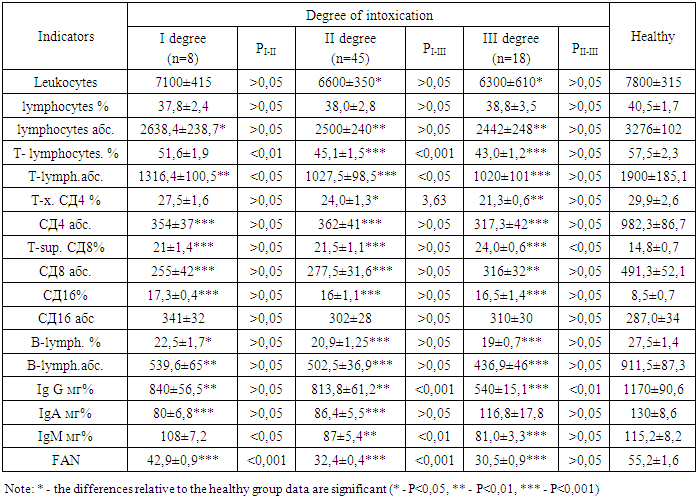-
Paper Information
- Next Paper
- Previous Paper
- Paper Submission
-
Journal Information
- About This Journal
- Editorial Board
- Current Issue
- Archive
- Author Guidelines
- Contact Us
American Journal of Medicine and Medical Sciences
p-ISSN: 2165-901X e-ISSN: 2165-9036
2024; 14(8): 2082-2084
doi:10.5923/j.ajmms.20241408.28
Received: Jul. 22, 2024; Accepted: Aug. 16, 2024; Published: Aug. 22, 2024

Influence of Endogenous Intoxication on the State of Immunological Reactivity in Children with Intestinal Obstruction
Ulugmuratov Azim Abriyevich
Samarkand branch of the Republican Scientific Center of Emergency Medical Care Republic of Uzbekistan, Samarkand, Uzbekistan
Correspondence to: Ulugmuratov Azim Abriyevich, Samarkand branch of the Republican Scientific Center of Emergency Medical Care Republic of Uzbekistan, Samarkand, Uzbekistan.
Copyright © 2024 The Author(s). Published by Scientific & Academic Publishing.
This work is licensed under the Creative Commons Attribution International License (CC BY).
http://creativecommons.org/licenses/by/4.0/

Intestinal obstruction in children is a very urgent problem already because of its wide prevalence. And the noted systemic and local immunological changes can be qualified as a secondary immunodeficiency state.
Keywords: Intestinal obstruction, Children, Immunological reactivity
Cite this paper: Ulugmuratov Azim Abriyevich, Influence of Endogenous Intoxication on the State of Immunological Reactivity in Children with Intestinal Obstruction, American Journal of Medicine and Medical Sciences, Vol. 14 No. 8, 2024, pp. 2082-2084. doi: 10.5923/j.ajmms.20241408.28.
1. Introduction
- According to WHO, intestinal obstruction in children occurs in 10% of cases in the structure of acute abdominal diseases. The mortality rate is up to 30%, and if intestinal obstruction developed in the postoperative period, it is up to 60%. The issues of diagnostics and treatment of intestinal obstruction (IO) in children are one of the highest priority tasks of pediatric surgery [1]. Despite the fact that there is a fairly long history of studying IO in children, such issues as the effectiveness of various methods of conservative treatment, the level of created intraintestinal pressure, the number and duration of attempts at disinvagination, control of intussusception straightening remain debatable [2,3]. The features of anesthetic care and postoperative management in laparoscopic operations for intestinal obstruction are insufficiently covered [5,7]. From this point of view, the development of all these issues is very relevant and has important scientific and practical significance, which served as the basis for this work [4,6].
2. Results and Discussion
- There is increasing evidence that the increased incidence and severity of IO in children depend on the child's reactivity, and changes in the specific and nonspecific reactivity of the homeostatic defense systems are the first and main conditions for the development of the infectious process. In this regard, our next task was to study the effect of endogenous intoxication on the immunological reactivity of young children with IO.Table 1 presents the results of studies of the immune system depending on the degree of intoxication in young children. When analyzing immunological parameters, it was found that in children during the peak of the disease, a significant decrease in the content of leukocytes, the absolute number of lymphocytes, T-lymphocytes, T-helpers is detected (P < 0.05 - < 0.001) and a significant increase in the indicators of T-suppressors (CD8) and T-killers (CD16), compared to the healthy group (P < 0.001).
|
3. Conclusions
- The immunological studies conducted at the height of IO in children indicate the development of immunological deficiency of both cellular and humoral links. An inversely proportional dependence of the indicators on the degree of endogenous intoxication was revealed.Summarizing the presented data, it should be noted that IO is a very urgent problem already due to its wide prevalence. And the noted systemic and local immunological changes can be qualified as a secondary immunodeficiency state.
 Abstract
Abstract Reference
Reference Full-Text PDF
Full-Text PDF Full-text HTML
Full-text HTML